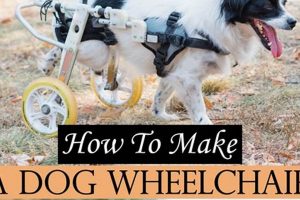The practice of creating canine cleansing solutions at home encompasses the formulation and preparation of grooming products intended for domestic dogs, utilizing readily available household ingredients. For example, a mixture of water, gentle dish soap, and vinegar can serve as a basic cleaning agent.
Preparing these solutions offers advantages, including cost-effectiveness and control over ingredient selection, mitigating potential allergic reactions to commercial products. Historically, homemade remedies were common before the widespread availability of specialized pet care items, reflecting a tradition of resourcefulness and attentive animal husbandry.
The following sections will detail safe and effective recipes, discuss considerations for different coat types and skin conditions, and provide guidance on proper application techniques for these self-made grooming aids.
Dog Shampoo DIY
The formulation of effective and safe canine cleansing agents requires careful consideration of ingredient selection and application techniques. The following guidance provides essential insights for individuals undertaking this process.
Tip 1: Prioritize Gentle Ingredients: Utilize ingredients known for their mild cleansing properties, such as Castile soap or baby shampoo. Harsh chemicals can strip the natural oils from a dog’s coat, leading to skin irritation and dryness.
Tip 2: Dilute Concentrated Solutions: Always dilute homemade mixtures with water before application. A general guideline is a 1:10 ratio of concentrated cleaning agent to water, ensuring even distribution and reducing the risk of chemical burns.
Tip 3: Avoid Irritants: Refrain from including substances known to irritate canine skin, such as artificial fragrances, dyes, or excessive amounts of essential oils. These additives can trigger allergic reactions or exacerbate existing skin conditions.
Tip 4: Conduct Patch Tests: Before applying a homemade shampoo to the entire body, perform a patch test on a small area, such as the leg or belly. Observe for any signs of redness, itching, or inflammation within 24 hours.
Tip 5: Control Water Temperature: Employ lukewarm water for rinsing and shampooing. Water that is too hot can scald the skin, while excessively cold water can cause discomfort and shivering.
Tip 6: Ensure Thorough Rinsing: Meticulously rinse all traces of the shampoo from the dog’s coat. Residual shampoo can cause skin irritation and attract dirt, negating the benefits of the cleansing process.
Tip 7: Consider Coat and Skin Type: Adapt the formulation to suit the dog’s specific coat and skin type. Dogs with sensitive skin may require hypoallergenic recipes, while those with oily coats may benefit from the addition of clarifying agents such as apple cider vinegar (in diluted form).
Tip 8: Consult Veterinary Professionals: For dogs with pre-existing skin conditions or sensitivities, consultation with a veterinarian or veterinary dermatologist is strongly advised. These professionals can provide tailored recommendations and identify potential contraindications.
Adherence to these guidelines contributes to the creation of safe and effective homemade canine cleansing agents, minimizing the risk of adverse reactions and promoting optimal skin and coat health.
The subsequent sections will explore specific recipes and address common concerns associated with creating homemade dog shampoos.
1. Gentle ingredients imperative
The necessity of gentle ingredients constitutes a foundational principle in the practice of creating canine cleansing solutions at home. The inherent sensitivity of canine skin mandates careful selection, as harsh chemicals common in commercial products can disrupt the natural skin barrier, leading to irritation and discomfort.
- pH Balance Considerations
Canine skin exhibits a higher pH level compared to human skin. Using products formulated for humans, often acidic, can disrupt the natural acid mantle, predisposing the dog to bacterial or fungal infections. Homemade solutions necessitate pH-neutral or slightly alkaline ingredients, minimizing the risk of imbalance.
- Minimizing Allergenic Potential
Many commercial dog shampoos contain artificial fragrances, dyes, and preservatives, common allergens for canines. Formulating homemade solutions allows for the exclusion of these potential irritants, mitigating the risk of allergic reactions. Common alternatives include hypoallergenic soaps and natural emollients.
- Maintaining Hydration
Harsh detergents can strip the skin of essential oils, leading to dryness and flakiness. Gentle ingredients, such as oatmeal or aloe vera, possess moisturizing properties that help maintain skin hydration and prevent dryness. These additions promote coat health and alleviate existing skin conditions.
- Avoiding Toxic Components
Certain ingredients, though safe for humans, are toxic to dogs. Tea tree oil, a common ingredient in some natural remedies, can cause neurological issues in canines if ingested or absorbed through the skin. Thorough research and careful ingredient selection are crucial to prevent accidental poisoning.
The adherence to the principle of utilizing gentle ingredients directly influences the safety and effectiveness of “dog shampoo diy.” By prioritizing pH balance, minimizing allergens, maintaining hydration, and avoiding toxic components, individuals can create solutions that promote canine hygiene without compromising their animal’s health or well-being, resulting in a superior and considerate cleansing regimen.
2. Appropriate dilution critical
The practice of diluting homemade canine cleansing solutions represents a critical step in ensuring the safety and efficacy of the product. Concentrated cleaning agents, even those considered mild, can pose risks of irritation or chemical burns to a dog’s skin if applied undiluted. Accurate dilution is not merely a recommendation but a fundamental requirement for responsible formulation.
- Preventing Skin Irritation and Chemical Burns
Direct application of concentrated solutions can disrupt the skin’s natural pH balance, leading to redness, itching, and inflammation. In severe cases, undiluted substances can cause chemical burns, resulting in significant discomfort and potential secondary infections. Dilution reduces the concentration of active ingredients, minimizing the likelihood of adverse reactions. For example, a concentrated Castile soap solution, if applied directly, can cause severe skin irritation, whereas a properly diluted solution cleanses gently without adverse effects.
- Ensuring Even Distribution and Rinsing
Dilution facilitates even distribution of the cleaning agent across the dog’s coat, ensuring comprehensive cleansing. Concentrated solutions tend to be viscous and difficult to spread, leading to uneven cleaning and potential build-up in certain areas. Diluted solutions penetrate the coat more readily, allowing for thorough cleansing and easier rinsing. Proper rinsing is essential to remove all traces of the cleaning agent, preventing residue buildup that can attract dirt and cause irritation.
- Optimizing Cleansing Efficacy
Counterintuitively, excessively concentrated solutions may not provide optimal cleansing. High concentrations of surfactants can cause excessive foaming, hindering the removal of dirt and debris. Dilution allows the surfactants to function more effectively, encapsulating dirt and oils for easier removal during rinsing. A properly diluted solution achieves a balanced cleansing action, removing impurities without stripping the coat of its natural oils.
- Economic Considerations
Diluting concentrated cleaning agents extends the lifespan of the product, making it more cost-effective. Using undiluted solutions wastes product, increasing the frequency of repurchasing. Proper dilution allows individuals to maximize the value of their ingredients, minimizing expenses while maintaining the quality and efficacy of the homemade shampoo.
The factors presented highlight the integral relationship between dilution and the health and well-being of the animal when engaged in “dog shampoo diy”. Through appropriate dilution, individuals can significantly reduce the risk of adverse reactions, optimize cleansing efficacy, and ensure the economic viability of their homemade cleaning agents, thus contributing to a safer and more effective grooming experience.
3. Irritant avoidance essential
The principle of irritant avoidance constitutes a cornerstone of responsible “dog shampoo diy” practices. Canine skin, inherently more sensitive than human skin due to differences in pH levels and epidermal thickness, exhibits a heightened susceptibility to irritation from various chemical compounds commonly found in commercial cleaning products. The inclusion of artificial fragrances, dyes, preservatives, and harsh surfactants can trigger a cascade of adverse reactions, ranging from mild dermatitis to severe allergic responses. Formulating homemade shampoos necessitates a meticulous selection of ingredients, prioritizing those with established safety profiles and a minimal propensity for causing irritation. Failure to adhere to this principle can negate the benefits of home formulation, exposing the animal to unnecessary discomfort and potentially exacerbating pre-existing dermatological conditions.
The implications of ignoring irritant avoidance are readily observable in clinical scenarios. For instance, the use of essential oils, touted for their natural cleansing properties, can lead to toxicities in canines due to their concentrated nature and differing metabolic pathways. Tea tree oil, while possessing antimicrobial properties, can cause neurological symptoms in dogs if absorbed through the skin or ingested. Similarly, the inclusion of artificial dyes, often employed to enhance the aesthetic appeal of commercial shampoos, can trigger allergic reactions in sensitive individuals, resulting in pruritus, erythema, and alopecia. The practical application of this understanding involves rigorous research into the safety profiles of all potential ingredients, opting for hypoallergenic alternatives, and conducting patch tests prior to full-body application to assess for individual sensitivities.
In summary, the importance of irritant avoidance in “dog shampoo diy” cannot be overstated. It directly impacts the health and well-being of the animal, minimizing the risk of adverse dermatological reactions. Challenges remain in identifying potential irritants and sourcing safe, effective alternatives, necessitating continuous education and vigilance. Adherence to this principle aligns with the broader goal of providing comprehensive and considerate care for canine companions, emphasizing the responsibility inherent in formulating homemade grooming products.
4. Patch testing necessary
In the realm of “dog shampoo diy”, patch testing emerges as a crucial preliminary step. It serves as a proactive measure to identify potential adverse reactions to homemade formulations before widespread application, safeguarding canine health and well-being.
- Identification of Allergic Sensitivities
Patch testing enables the detection of individual sensitivities to specific ingredients. Canines, like humans, can exhibit allergic reactions to a variety of substances, including essential oils, plant extracts, and even seemingly benign components such as oatmeal. A patch test isolates a small area of skin to observe for signs of irritation or inflammation, indicating an allergic response to a particular ingredient.
- Prevention of Systemic Reactions
While localized skin irritation is a common manifestation of allergies, systemic reactions, though less frequent, can occur. These reactions may involve respiratory distress, gastrointestinal upset, or, in severe cases, anaphylaxis. By identifying sensitivities through patch testing, the risk of triggering systemic reactions with full-body application is significantly reduced.
- Assessment of Irritant Potential
Beyond allergic sensitivities, certain ingredients may possess inherent irritant properties, even in the absence of a true allergic response. Highly concentrated solutions or substances with extreme pH levels can cause chemical burns or dermatitis. Patch testing allows for the assessment of the irritant potential of the formulated shampoo, ensuring it is sufficiently diluted and gentle for canine skin.
- Optimization of Formulation Safety
The results of patch testing directly inform the refinement of shampoo formulations. If a particular ingredient elicits an adverse reaction, it can be excluded from the recipe, or its concentration can be adjusted to minimize its irritant potential. This iterative process of testing and modification allows for the creation of a customized shampoo that is both effective and safe for the individual dog’s skin.
The insights gained through patch testing are integral to the responsible practice of “dog shampoo diy.” By prioritizing this preliminary step, individuals can minimize the risk of adverse reactions, optimize the safety of their homemade formulations, and promote the long-term health and well-being of their canine companions.
5. Temperature control vital
Temperature control constitutes a critical, yet often overlooked, aspect of “dog shampoo diy”. Water temperature directly impacts both the efficacy of the cleansing process and the physiological comfort of the animal. Deviations from an optimal range can lead to adverse outcomes, potentially negating the benefits of homemade formulations.
- Thermoregulatory Impact
Canines possess different thermoregulatory mechanisms compared to humans. Exposure to excessively hot water can overwhelm their cooling systems, leading to hyperthermia or heat stress. Conversely, water that is too cold can induce hypothermia, particularly in smaller breeds or those with thin coats. Maintaining a lukewarm temperature, typically between 98F and 102F (36.7C and 38.9C), minimizes the risk of disrupting the dog’s internal temperature balance.
- Cutaneous Perfusion and Cleansing Efficacy
Water temperature influences cutaneous perfusion, the blood flow to the skin. Warm water promotes vasodilation, increasing blood flow and potentially enhancing the absorption of shampoo ingredients. However, excessive heat can damage skin cells and exacerbate inflammation. Lukewarm water strikes a balance, allowing for sufficient cleansing without compromising skin integrity. This optimal perfusion aids in the removal of dirt, debris, and excess oils from the coat.
- Sensory Perception and Behavioral Response
The temperature of the water significantly affects the dog’s sensory experience. Water that is too hot or too cold can cause discomfort, leading to anxiety and resistance to the bathing process. A positive bathing experience relies on minimizing stressors, and using lukewarm water contributes to a more relaxed and cooperative demeanor. This, in turn, facilitates a more thorough and effective cleansing.
- Shampoo Solubility and Rinse Efficiency
Water temperature affects the solubility of shampoo ingredients. Warmer water generally improves the dissolution of surfactants and other cleaning agents, enhancing their ability to emulsify dirt and oils. However, excessively hot water can denature proteins and damage sensitive ingredients. Lukewarm water provides a suitable compromise, promoting efficient cleansing while maintaining the integrity of the shampoo formulation. Furthermore, adequate rinsing is facilitated by lukewarm temperatures, ensuring removal of all shampoo residue, which can cause skin irritation if left behind.
These interconnected factors underscore the necessity of meticulous temperature control in the “dog shampoo diy” process. Employing lukewarm water within the recommended range promotes both the dog’s physiological well-being and the efficacy of the homemade cleansing solution. Consistent attention to water temperature contributes to a safer, more comfortable, and ultimately more successful grooming experience.
6. Thorough rinsing required
The imperative of thorough rinsing in the context of “dog shampoo diy” constitutes a fundamental element for ensuring canine hygiene and dermatological health. Inadequate rinsing following the application of homemade cleaning agents can negate the intended benefits, potentially leading to a range of adverse outcomes.
- Residue Accumulation and Skin Irritation
Residual shampoo, irrespective of its formulation, can accumulate on the skin surface and within the coat. This residue disrupts the natural skin barrier, predisposing the animal to irritation, pruritus, and inflammation. Homemade shampoos, even those composed of purportedly gentle ingredients, can cause adverse reactions if not completely removed. For example, residual oatmeal-based shampoo can create a breeding ground for bacteria and yeast, exacerbating skin conditions.
- Compromised Coat Quality
Shampoo residue can negatively impact coat quality, leading to a dull, sticky, or matted appearance. The build-up of cleaning agents interferes with the natural oils that contribute to a healthy, lustrous coat. This interference can also attract dirt and debris, accelerating the rate at which the coat becomes soiled. Consequently, the frequency of bathing may need to be increased, potentially further stressing the skin.
- Allergen Retention
If the shampoo formulation contains potential allergens, inadequate rinsing prolongs exposure and increases the likelihood of triggering an allergic response. Even if the initial application does not elicit a reaction, prolonged contact with residual allergens can lead to sensitization over time. This is particularly relevant for homemade shampoos, where ingredient purity and concentration may vary. For instance, incomplete rinsing of a shampoo containing essential oils could result in sustained exposure, potentially causing dermatitis.
- Potential for Ingestion and Toxicity
Dogs often groom themselves by licking their fur. Residual shampoo, if ingested, can cause gastrointestinal upset, including vomiting and diarrhea. While most homemade shampoo ingredients are generally considered safe in small quantities, prolonged or repeated ingestion can lead to cumulative toxicity. This risk is especially pertinent for shampoos containing ingredients such as essential oils or concentrated soaps. Therefore, meticulous rinsing minimizes the potential for ingestion and associated health risks.
These considerations underscore the vital connection between thorough rinsing and the success of “dog shampoo diy”. The benefits of using homemade formulations, such as ingredient control and cost-effectiveness, are contingent upon meticulous rinsing practices. Failure to prioritize thorough rinsing can compromise canine health and negate the intended advantages of creating homemade cleaning agents.
7. Coat/Skin type specific
The tailoring of canine cleansing solutions to specific coat and skin types represents a critical facet of responsible “dog shampoo diy”. A universal formulation is unlikely to address the diverse needs presented by various breeds and individual animals. Effective and safe home formulation necessitates a nuanced understanding of canine dermatological variations.
- Varying Sebaceous Gland Activity
Different breeds exhibit varying levels of sebaceous gland activity, influencing the natural oil production of the skin. Breeds prone to oily skin, such as Cocker Spaniels, benefit from shampoos formulated to degrease and remove excess sebum, preventing seborrhea. Conversely, breeds with naturally dry skin, like Huskies, require moisturizing formulations to replenish lost oils and prevent dermatitis. Formulating the solutions requires knowing their skin condition.
- Coat Density and Texture
Coat density and texture directly impact the distribution and retention of cleansing agents. Breeds with thick, double coats, such as German Shepherds, require formulations that penetrate the dense fur and effectively remove dirt and debris from the undercoat. Conversely, breeds with short, smooth coats, like Boxers, require gentler formulations that do not strip the skin of its natural oils. Formulating needs to match what coat is there.
- Presence of Skin Conditions
Pre-existing skin conditions, such as allergies, dermatitis, or infections, necessitate specialized shampoo formulations. Dogs with allergies may require hypoallergenic shampoos free of common irritants. Dogs with dermatitis may benefit from medicated shampoos containing ingredients such as oatmeal or aloe vera to soothe and reduce inflammation. Understanding the condition help address with specific shampoo mix.
- Age and Physiological State
The age and physiological state of the animal can influence skin sensitivity and reactivity. Puppies typically possess more delicate skin than adult dogs, requiring gentler formulations. Similarly, pregnant or lactating females may exhibit increased skin sensitivity due to hormonal fluctuations. Understanding the condition may require gentler formulations.
The aforementioned factors underscore the necessity of adapting “dog shampoo diy” formulations to the unique characteristics of each animal. Ignoring these considerations can lead to ineffective cleansing, skin irritation, or exacerbation of pre-existing dermatological conditions. Effective formulation necessitates meticulous observation, careful ingredient selection, and a thorough understanding of canine dermatological principles.
Frequently Asked Questions
This section addresses common inquiries concerning the formulation and application of homemade canine cleansing agents, providing concise and evidence-based responses.
Question 1: Is homemade canine shampoo inherently safer than commercially available options?
The safety of both homemade and commercial canine shampoos depends entirely on the ingredients used and the specific sensitivities of the animal. Homemade solutions offer control over ingredient selection, potentially mitigating exposure to known allergens. However, inaccurate formulation or the use of inappropriate ingredients can pose significant risks.
Question 2: What are the primary risks associated with “dog shampoo diy”?
The primary risks include skin irritation, allergic reactions, chemical burns (from improper dilution), and toxicity (from the inclusion of harmful ingredients such as certain essential oils). Thorough research and careful ingredient selection are paramount to minimizing these risks.
Question 3: Can homemade canine shampoo effectively treat existing skin conditions?
While certain ingredients, such as oatmeal or aloe vera, may provide symptomatic relief for some skin conditions, homemade shampoos are generally not a substitute for veterinary-prescribed treatments. Consultation with a veterinarian is essential for diagnosing and managing canine dermatological issues.
Question 4: How frequently can homemade canine shampoo be used?
The frequency of bathing depends on the breed, coat type, and activity level of the dog, as well as the formulation of the shampoo. Over-bathing can strip the skin of its natural oils, leading to dryness and irritation. Generally, bathing no more than once every one to two months is advisable, unless otherwise directed by a veterinarian.
Question 5: What ingredients should be strictly avoided in “dog shampoo diy”?
Ingredients to avoid include artificial fragrances and dyes, parabens, sulfates, phthalates, tea tree oil (melaleuca), and high concentrations of essential oils. These substances can cause irritation, allergic reactions, or toxicity in canines.
Question 6: How can the shelf life of homemade canine shampoo be extended?
Homemade shampoos typically lack the preservatives found in commercial products and have a shorter shelf life. Refrigeration can help to extend their usability. However, it is advisable to prepare small batches and discard any solution that exhibits signs of spoilage, such as discoloration or an unusual odor.
The successful implementation of “dog shampoo diy” practices hinges on a comprehensive understanding of canine dermatological needs, coupled with meticulous attention to ingredient selection and formulation techniques. Consultation with veterinary professionals is strongly encouraged to address individual animal needs and mitigate potential risks.
The subsequent section will explore specific recipes and formulation guidelines for homemade canine shampoos.
Conclusion
This exploration of canine cleansing solution formulation emphasizes critical factors for safe and effective application. Ingredient selection, proper dilution, irritant avoidance, patch testing, temperature control, thorough rinsing, and consideration of coat and skin type represent paramount concerns. Adherence to these principles mitigates adverse reactions and promotes canine well-being.
The creation of homemade canine cleansing solutions demands informed decision-making and meticulous execution. Prioritizing safety and efficacy through diligent research and consultation with veterinary professionals ensures responsible grooming practices. Continual assessment and adaptation of formulations to meet individual animal needs remain essential for optimal results.







